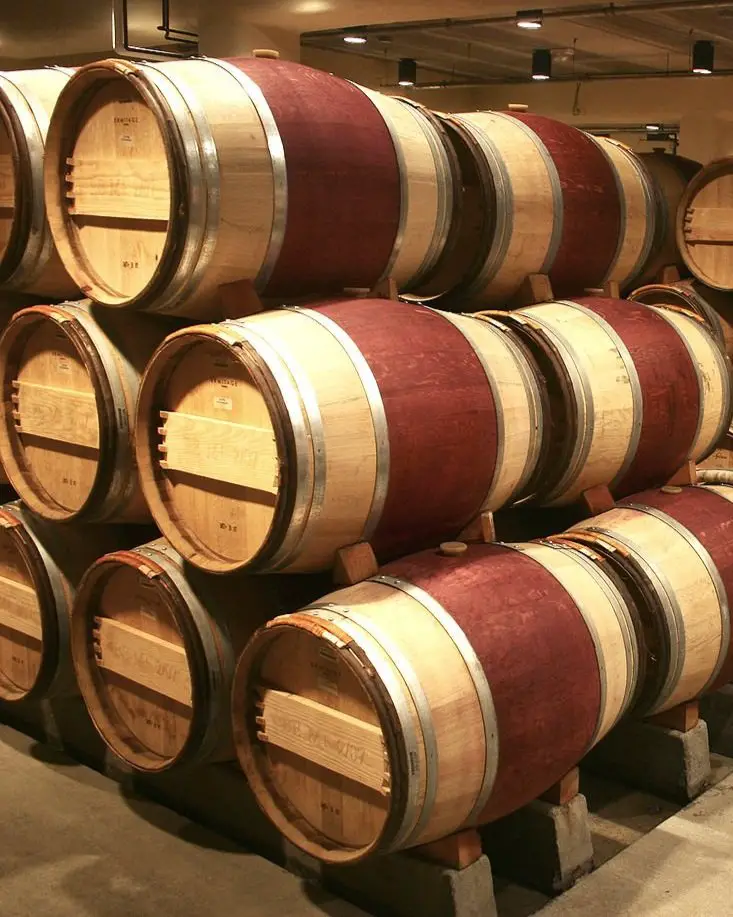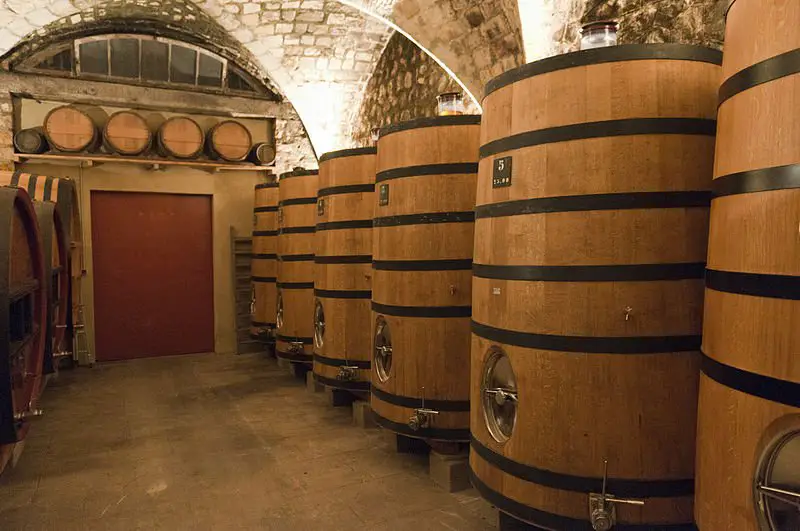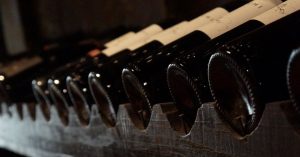French vs American Oak Wine Barrels
| Characteristic | French Oak | American Oak |
|---|---|---|
| Cost (New Barrel) | $800 – $2,500 | $400 – $1,200 |
| Price per Bottle (Estimate) | $4 | $2.50 |
| Flavors | Subtle, complex, vanilla, spice | Bolder, stronger, vanilla, coconut, dill |
| Oak Forest Locations | Central France (e.g., Limousin, Allier) | Various regions in the United States |
| Wines Traditionally Made | Bordeaux blends, Burgundy (Chardonnay, Pinot Noir) | Tempranillo, Rioja, Zinfandel |
Winemakers have relied on oak to store wine for well over a thousand years. Why?
Oak is one of the few ingredients winemakers can use to manipulate a wine’s flavor, adding spice, mocha, toast, and caramel. Additionally, oak barrels help stabilize red wine color. Different types of oak, like American, French, or Slavonian barrels, all have different attributes that will shape a wine. Oak barrels are expensive, and some producers use oak alternatives, like chips, staves, and shavings.
Here’s what you need to know about oak and wine.

- The Role of Oak Barrels in Winemaking
- How Are Oak Wine Barrels Made?
- How Do Winemakers Decide What Kind of Oak to Use?
- What Are the Sizes of Wine Barrels?
- Can Wine Barrels Be Used More than Once?
- What Are Oak Alternatives in Winemaking?
- Final Thoughts: Oak Wine Barrels as a Classic Symbol
- Thirsty for More?
The Role of Oak Barrels in Winemaking
Oak barrels play a crucial role in winemaking, offering winemakers a way to enhance and shape the flavor profile of their wines.
The use of oak in winemaking has a rich history, involving a combination of tradition, chemistry, and economic considerations.
There are two primary types of oak commonly used in winemaking: French oak and American oak.
A Brief History of Oak in Winemaking
Oak has been utilized for wine storage for thousands of years. Initially, clay jars called amphorae were used to transport and store wine during classical antiquity.
However, around 2,000 years ago, barrels made their appearance, believed to have been developed by Europe’s Iron Age communities.
The Romans discovered the technology during their conquests in ancient Gaul and began using barrels to transport wine.
Preserved barrels have been found in archaeological sites such as Pompeii and along the Rhine in Germany.
Over time, barrels evolved from practical storage containers to becoming a symbol of fine wine and craftsmanship.
French Oak for Winemaking

French oak is highly regarded in the winemaking industry and considered the best oak for winemaking worldwide.
French coopers, or barrel makers, make an impressive 500,000 barrels/year. Winemakers consider these barrels to be the best in the world for winemaking.
But just what’s so special about French oak? It all starts in the forest…
Fun Wine Fact: The French have been meticulous in managing their forests since the 1600s, with the aim of providing suitable wood for shipbuilding in the age of sail.
Fast forward to modern times, and while we no longer use sailing vessels, these forests continue to yield premium oak trees, which are used by winemakers.
French oak undergoes a meticulous process before becoming wine barrels. The staves are air-dried for two years, eliminating unwanted compounds, and then split.
However, due to the labor-intensive process and the high cost of French oak barrels (upwards of $1200 per barrel), they are primarily used for premium wines and not suitable for entry-level or mid-range wines.
This comes out to $20/gallon or $4/bottle – just for the oak!
Premium wines see a greater proportion of French oak. Due to the barrel’s cost, French oak isn’t suitable for entry and mid-range wines.
American Oak for Winemaking

Fun fact: There’s no sales tax on wine barrels in California (and many other states) because it’s considered a food ingredient. Who knew, right?
American oak, sourced from Missouri and Oregon, but are two different varieties of trees: Quercus alba and Quercus garryana. Originally coopers bent the staves using steam, but that produced dill flavors in the wine. Not delicious.
Today staves are bent over fire, similar to French oak.
Fun Wine Fact: American oak has a history rooted in the bourbon industry and offers distinct characteristics to wines.
American oak is denser than French oak. This denseness allows the wood to be sawn instead of split, resulting in more usable wood from each tree.
The faster growth of American oak trees leads to looser grains, enabling the wine to absorb the flavors more rapidly than French oak.
American oak barrels are commonly used for red wines with robust character, such as Sangiovese and Rioja.
They are priced at around $600 per barrel, making them a more cost-effective option compared to French oak.
Quick review: American oak grows faster and can be sawn, reducing overall production costs. An American oak barrel comes in around ~$600/barrel, far below French oak’s $1200/barrel. This will translate into about $10/gallon of wine or $2.50/bottle.
How Are Oak Wine Barrels Made?

Winemakers will order oak barrels specifying exactly what they want. Check out this great video of a cooperage in Burgundy.
After sawing and hewing the wood, staves are left to mature and leach out bitter compounds for several years. Then, the cooper selects the staves to craft the barrel.
Some coopers will blend wood from different forests under the assumption that there are greater forest-to-forest differences than tree-to-tree differences.
Oak wine barrels are toasted over a flame.
Toasting the barrel produces different flavor traits.
- A dark toast will give the wine more chocolate and mocha notes.
- A medium toast imparts clove, vanilla, and toffee.
- A light toast enhances fruitiness.
Barrel makers employ a technique called ‘graduated toasting’, where they expose the staves to different levels of toast to achieve distinct flavors.
Fun Wine Fact: All of the non-fruity delicious descriptors you see on a wine label – from mocha to burnt caramel – originate in the toasted oak’s surface.
How Do Winemakers Decide What Kind of Oak to Use?
The choice between French and American oak depends on winemakers’ preferences and the desired style of wine.
Winemakers have the opportunity to customize their wine by selecting the wood species, source, tightness of grain, degree of toasting, and other factors.
In addition to flavors, oak barrels help:
- Slow aeration
- Color stabilization in red wines
- Tannin softening
In the realm of winemaking, economics plays a significant role in determining the use of oak barrels.
Helpful Tip: Here’s a full post that looks at the flavors oak barrels add to wine.
Barrels are expensive to purchase, maintain, and involve losses due to ullage (evaporation) during aging.
In markets with tight profit margins or large-scale operations, the use of barrels may not be realistic.

What Are the Sizes of Wine Barrels?
Popular Wine Barrel Sizes
| Barrel Type | Size |
|---|---|
| Burgundy barrels | 228L/60gl |
| Bordeaux barrels | 225L/59gl |
| Hogsheads | 80gl |
| Puncheon | 120gl |
The two commonly used sizes for wine barrels are the 225-liter/59-gallon barrels known as “barrique bordeleaise”, or Bordeaux barrels, which are narrow and long, and Burgundy Barrels, which are short and fat at 228L/60 gallons.
Wine barrels come in a dizzying number of sizes, but the two main types sold today are export barrels and chateaux barrels:
- Export barrels are used for shipping. They have thicker staves that result in less evaporation (less loss of wine). They’re more durable for heavy transport.
- Chateau barrels are what you see in romantic winery images. They have thinner staves, are more porous (more evaporation), and have a recessed head and headboards making them easier to grip and handle.
How does the size of the oak barrel impact winemaking?

The smaller the wine barrel, the faster the oak flavors will transfer to the wine because there’s a greater surface-to-wine ratio.
In contrast, larger barrels have less surface-to-wine contact, and the overall flavor from the barrel will be less pronounced.
Let’s do some comparisons:
- A huge wooden tank that holds 2500 gallons will have 9.3 gallons of wine for every square foot of wood surface
- An 80 gl hogshead will have 2.7 gallons of wine for every square foot of wood surface.
The smaller the barrel, the more noticeable the oak’s impact will be.
What’s Ullage in Winemaking?
Ullage refers to water and/or alcohol evaporation from the wine inside the barrel. Evaporation rates depend on humidity, which is why barrel aging rooms are so humid, and why caves make for ideal barrel storage.
How to Pronounce Ullage: Ullage – variously pronounced as ‘uhl-age’ or ‘you’ll-age’ depending on your regional accent. ‘Uhl-age’ is the most common.
Evaporation concentrates flavors and acids. If the wine is of good quality, evaporation will improve the wine over time.
Fun Wine Fact: Between .5 and 2.5 gallons of wine will evaporate each year depending on the ambient humidity. A wine that’s aged for 2 years will lose between 1 (5 bottles) and 5 gallons (2 cases) of wine during aging.
Slight detour here. Let’s talk economics.
If your wine sells for $20/bottle, that’s upwards of a $240 loss per barrel. If you’re making 10 barrels, that’s $2400, but if you’re making 100 barrels, that could be upwards of $24,000 of wine loss through evaporation.
Check out this winery in Argentina hosing down its barrels. The climate’s so dry, that they need to wet them down every day to prevent the wine from evaporating.
Okay, back to barrel maintenance.
- White wines in the barrel need to be checked regularly, every 1-2 weeks.
- Reds are a little more durable and can be checked every few months.
You’ve seen those pictures of row upon row of wine barrels stacked 5 high and 15 deep. This means that a cellar worker is climbing through those barrels regularly to top up wines.
I’ve got one word for you: logistics.
Can Wine Barrels Be Used More than Once?

Barrels are always used more than once. Barrels impart flavor to the wine for about 3-4 years, after that they’re considered ‘neutral’. They’re still used for storing and aging wine, but all of the toasty flavors have been absorbed by previous vintages.
Coopers can extend the shelf life of a barrel by shaving the inside and retoasting the barrel.
This is called reconditioning a wine barrel.
Reconditioning a barrel costs about $200/barrel; this is a pretty good deal. Unfortunately, the toasting won’t be uniform, and the barrels won’t be as strong for stacking.
Wine barrels aren’t cheap. Not to purchase. Not for winemaking. Not to maintain.
So, How Much Does It Really Cost to Use Oak Barrels in Winemaking?
I put together this video overview that gives a quick breakdown of the costs for oak barrels in winemaking. Check it out.

What Are Oak Alternatives in Winemaking?
Oak alternatives like chips and staves can provide similar flavor effects at a fraction of the cost. While barrels have been the traditional choice, the rise of oak alternatives offer a more cost-effective solution, albeit without the micro-oxygenation benefits of barrels
Check out this video that shows how a winemaker uses oak staves in an old, neutral oak barrel that no longer contributes oak flavors:

Oak Slats and Oak Staves
Oak slats or staves can replace barrels of any style. Unlike a barrel where only the inside of the container touches the wine, a stave goes into the aging vessel and the wine surrounds the wood, using the entire surface area.
Oak Chips
These look like garden woodchips or shavings. Wineries purchase chips with different levels of toast to add to the wine in bulk.
Both slats and chips infuse the same flavors and aromas as their barrel counterparts: vanilla, coconut, butterscotch, etc.
Are Oak Alternatives Better than Oak Barrels?
One argument against oak barrels (besides cost), is that winemakers only use the inside of the barrel for their winemaking.
A significant amount of the wood’s surface area goes unused and this is wasteful.
Neither slats nor chips can mimic the benefits of micro-oxygenation to soften tannins, but winemakers can use a bubbler to mimic the effects of barrel aeration.
Winemaking science is at an inflection point where winemakers can almost perfectly mimic the effects of oak using chips, staves, and technology.
And with oak alternatives coming in at 1/10th the cost and imparting flavors in 5 months, what’s not to like?
Final Thoughts: Oak Wine Barrels as a Classic Symbol

At the end of the day, winemaking is an economic enterprise – a food manufacturing venture – and a producer has to break even.
Hopefully a little more than break even.
Personally, I love seeing stacks of barrels in wineries and running my hands over well-hewn staves.
Maybe it’s because for me they hint at a time in the past when freight moved in the hulls of rolling ships sporting billowing sails – adventure and opportunity on the horizon.
Barrels are nice and all, but… Economic concerns will drive the future use of oak barrels.
In tight markets or large operations where winemakers have to meet thin profit margins, barrels are unrealistic. That said, barrel alternatives, like chips and staves, can achieve similar effects in wine.
I would argue that it’s a greater tribute to the winemakers’ skills if they’re able to recreate the barrel effect sans barrel.
Barrels. A small piece of human history still tethering us to the past.
Thirsty for More?
Just getting started in wine? Check out this post on 11 famous wine regions and their signature wine styles.
Fermentation is the magic of turning juice into wine. Here’s an overview of how wine fermentation works. It’s a little nerdy, but you might just like it!




